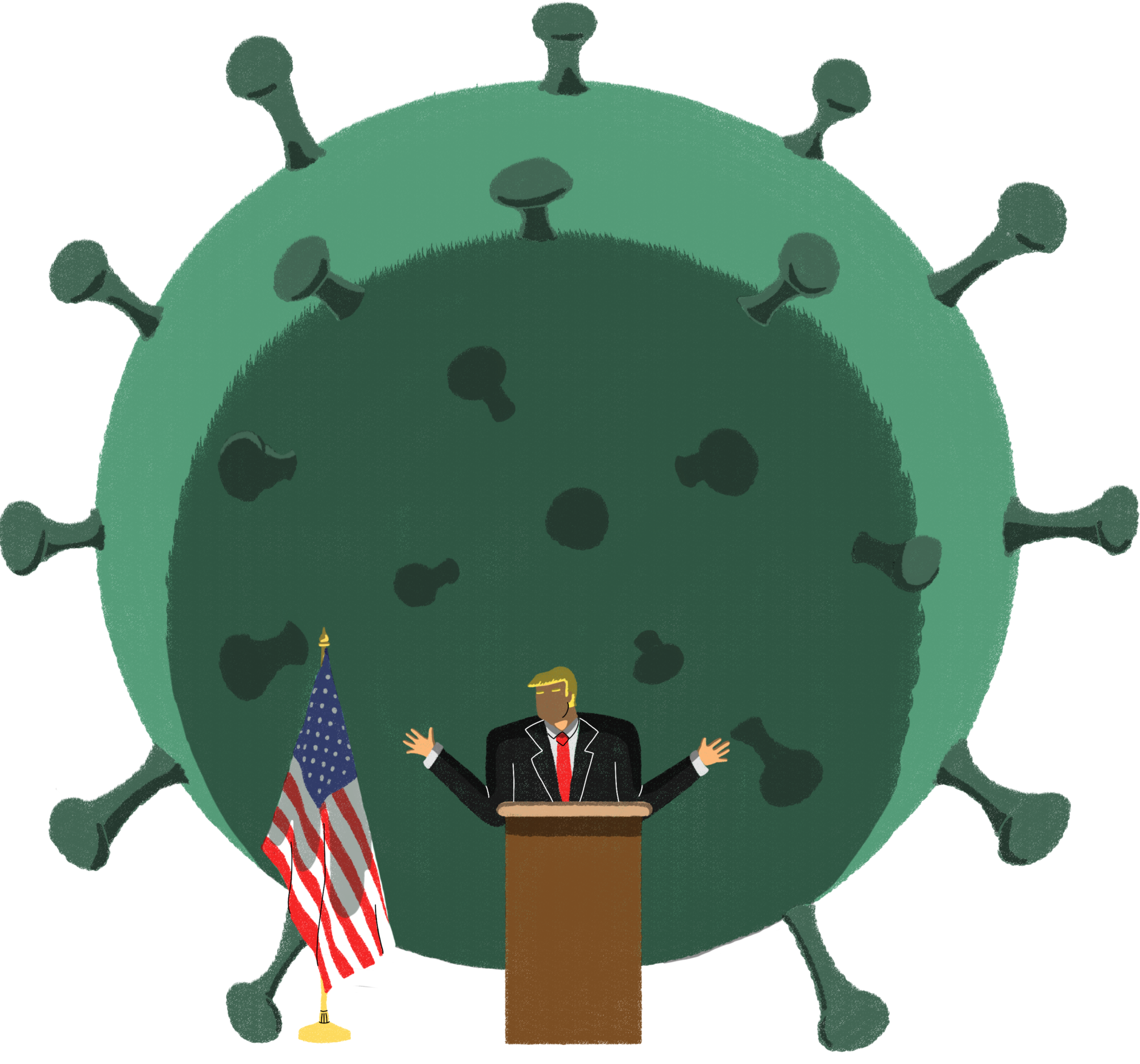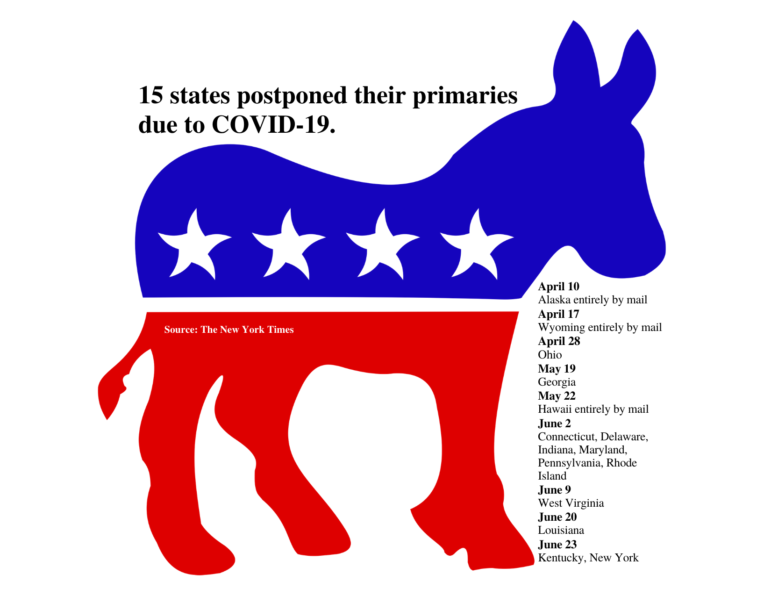
By Erika Pilpre and Peyton De Winter
At this time, it seems as if the developments of the 2020 election have been pushed away from the media as the coronavirus incites panic, stealing the attention of voters. With developments of the virus crowding the news, it’s hard to hear about anything other than the public health crisis. The coronavirus has topped the charts both nationwide and worldwide, and thus, dealing with it is going to be the main issue surrounding the 2020 election.

Major events involving the United States have been set aside as the coronavirus sweeps across the world. Primaries have been postponed. The Olympics were pushed to 2021. But many, such as Democratic candidate Joe Biden, who was recently endorsed by Senator Bernie Sanders, are saying that the presidential election should remain in action in November. Under the 20th Amendment of the Constitution, the President’s term ends on Jan. 20 and the new Congress starts on Jan. 3. They argue that elections were held during times of crisis such as the Civil War and World War II, so the 2020 election should occur as well. However, this argument fails to acknowledge that the pandemic is forcing people to steer six feet clear of each other, making it nearly impossible for traditional voting systems to be carried out without the risk of spreading the virus.
“We are fortunate to have been one of the first counties to implement the Voter’s Choice Act”
San Mateo County Elections Division Management Analyst Travis Dunn believes that the election will not be pushed back, even with delays in ballot counts.
“Some states still use Direct-Recording Electronic voting machines, where the votes cast can be tallied in an instant. These areas may not yet be equipped to process results from an election where every vote is cast on paper, mail-in voting. Even offices that are well equipped may experience delays based on decreased staffing levels,” Dunn said. “That said, I am completely confident that this will not delay the voting of the Electoral College or the inauguration of the President.”
For San Mateo, systems have been set in place to shift to all-mail voting.
“We are fortunate to have been one of the first counties to implement the Voter’s Choice Act, which provides every voter with a mailed ballot. No office can function without staff, however, and fear of COVID-19 may affect the number of seasonal workers willing to work with us during the election,” Dunn said. “We are already working to ensure we have a sufficient workforce to conduct the Presidential Election without impact. Our Student Democracy Program, which brings in high school students to serve vital roles at the Vote Centers, is also seeking applicants.”
Some state voters aren’t so lucky. A growing number of Republican states are using the excuse of “voter fraud” to prevent a higher voter turnout in order to keep President Donald Trump in office for a second term. In Wisconsin, a voter-ID law requiring a photo ID when voting was passed by Republicans in legislature. This was done under the excuse of the supposed “voter fraud” spawned by the possibility of a defeat.
Trump’s current response to the coronavirus has created major setbacks for millions of Americans. His focus has been on the economy and the stock market rather than on the improvements of the public healthcare system. With the public health emergency and impending recession, Trump’s inability to respond adequately to the situation may play a greater deal in the 2020 election than he thinks.
In his press briefings, Trump is known to be detached from the facts of the matter at hand. He frequently insists that the situation is improving, when in reality, the pandemic is worsening every second. This is dangerous, especially at moments like this when the lives of his citizens are in danger as the infected population steadily grows.
Trump’s re-election campaign is now focused on what the President has done thus far to improve the coronavirus situation, such as the early travel bans in Asia and Europe, in an effort to convince wavering voters to vote for him.
With states like California anticipating the potential of on and off lockdowns in future months, all eyes are on the government to see how the situation will be handled. So far, the national government has taken limited action, despite twelve state governments passing shelter-in-place orders.

At least 15 states have postponed their primaries. Louisiana already rescheduled its primary from April 4 to June 20 and Georgia from March 24 to May 19. The Democratic National Convention has also pushed back the convention to Aug. 17.
By November, it is unclear whether conditions will be under control. Many states are opening up options towards expanding mail-in votes. The Senate coronavirus relief bill planned on giving the states $400 million to protect the impending election from the threat of the virus. This money would be allocated to pushing for mailed ballots and securing of in-person voting areas.
Regardless of what is decided, protecting poll workers, as well as voters, is a priority. If poll workers refuse to interact with hundreds of people in November, the entire system could fall into chaos nationwide. Something will have to be done to help prevent this from happening, and right now, online voting is the main hope for the 2020 election.
Technology has improved the quality of life in recent years. However, from the app fiasco during the Iowa caucuses, where it took weeks to find out the true result, it seems as if the election department has experienced a slow start. Due to current conditions, a greater shift towards implementing technology in voting might be necessary, becoming the turning point towards technology-based elections.
“A lot of people don’t have [access to the] Internet, especially the rural communit[ies]”
While shifting towards online voting could work, there are some major flaws with that idea as well.
“[Online voting is] a bad idea because a lot of people don’t have [access to the] Internet, especially the rural communit[ies],” said senior Albert Hao. “A lot of rural areas have basically no coverage. That’s going to be a problem.”
Dunn agrees that voting through the internet is yet to be a method implemented across the country, but other technological systems are used person to person.
“For instance, San Mateo was the first county in the state to implement a Remote Accessible Vote by Mail service for voters with disabilities,” Dunn said. “This system allows the voter to download their ballot and mark their choices on a personal computer, then print out and return their ballot via mail. In the event of postal service disruption, or disruption to the ballot printing supply chain, this technology could perhaps find a much wider application for the general voting public.”





Great article! Well sourced and written.